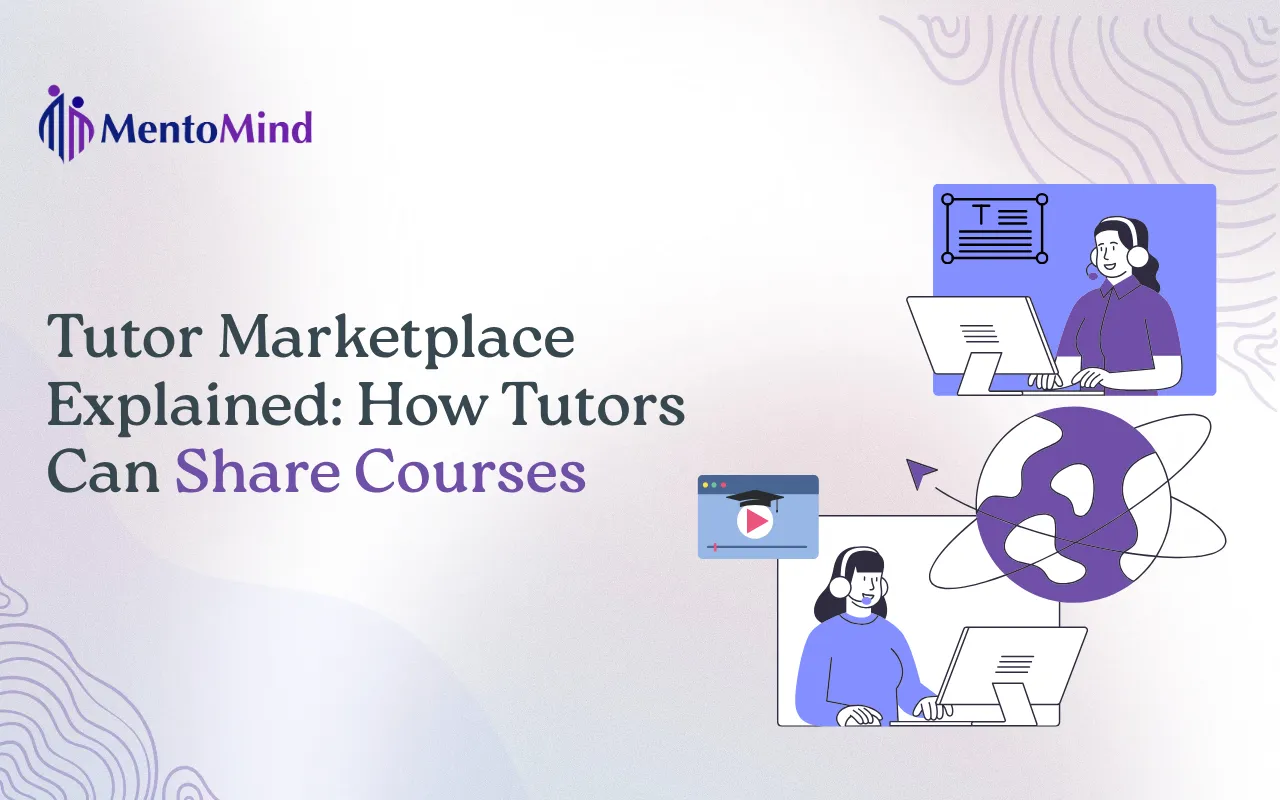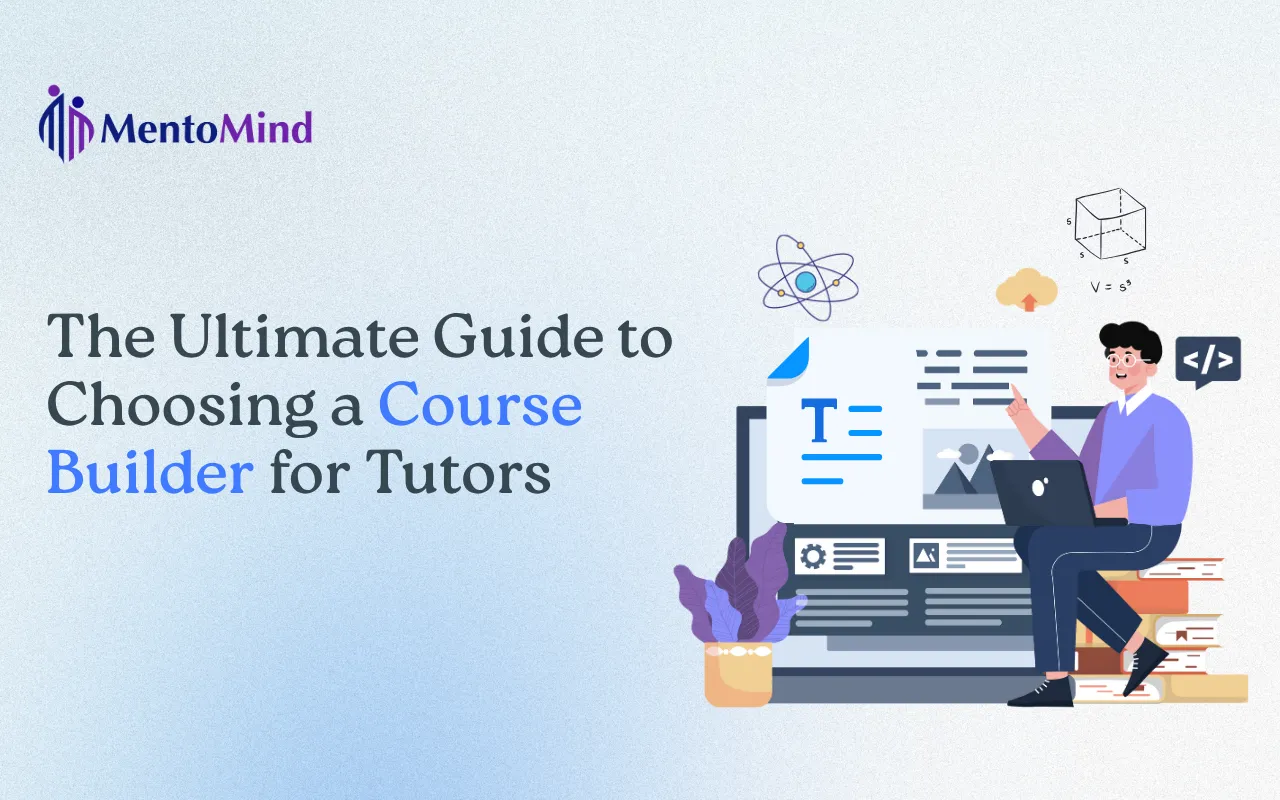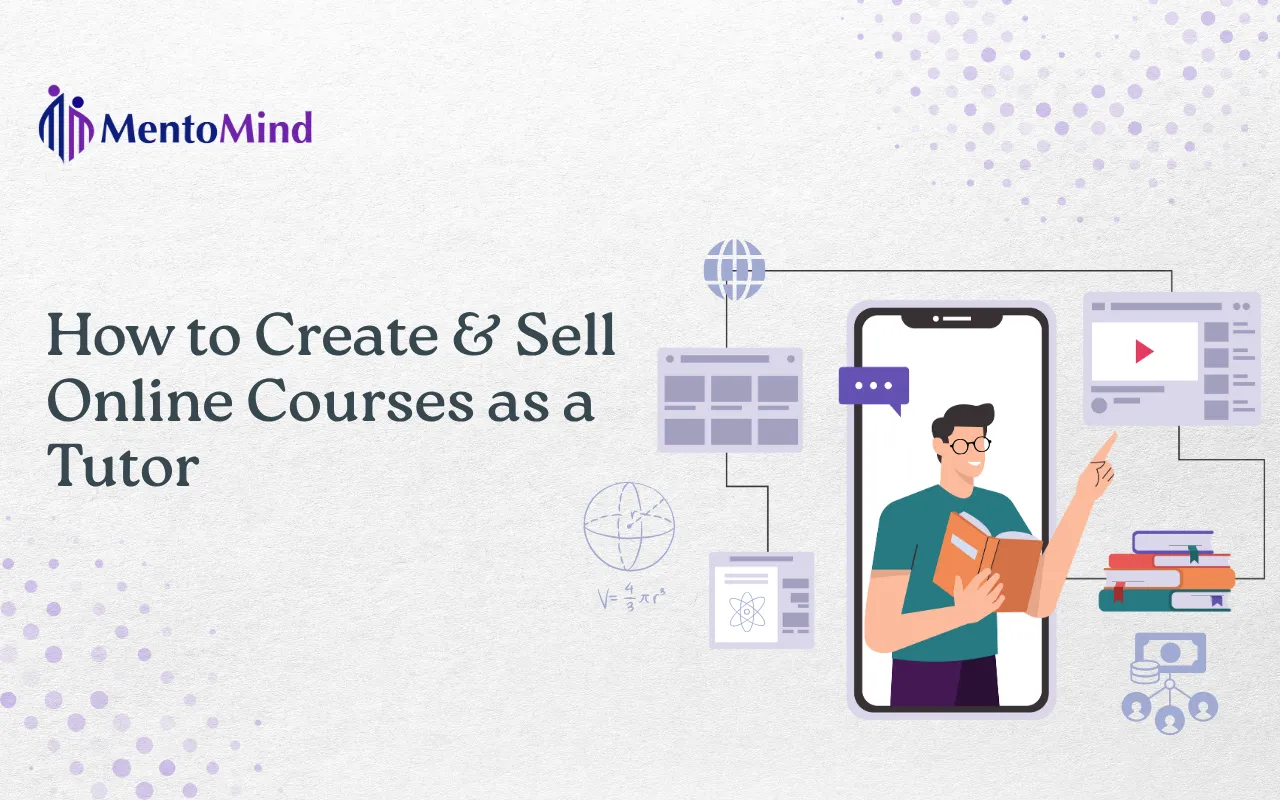Tutors today are extending their reach beyond live sessions by publishing structured courses in online marketplaces. Instead of keeping courses stored privately, educators can make them discoverable, enroll students easily, and offer structured learning without being limited to scheduled teaching hours.
A tutor course marketplace connects course creation, discovery, and monetization inside one system built specifically for educators. This guide explains how tutor marketplaces work, why they matter, and how to leverage them for your teaching business.
What Is a Tutor Course Marketplace?
A tutor course marketplace is an online platform where educators upload self-created courses and make them accessible to students. It functions as a digital library of structured lessons, practice content, and assessments created by subject experts.
Unlike generic course websites focused on direct sales, a tutor course marketplace centers on discoverability, structure, and learning delivery. Educators can:
- Publish courses for student enrollment
- Offer free or paid access based on teaching models
- Set clear learning outcomes, modules, and assessments
- Track student progress and engagement
This approach helps tutors scale their teaching reach while ensuring students access professional, well-organized learning experiences.
Why Are Tutor Marketplaces Growing in Popularity?
Traditional tutoring depends heavily on live sessions and personal referrals. As learning becomes more flexible and self-paced, tutors need ways to organize content professionally and reach more students without increasing teaching hours.
Key Drivers of Growth:
- Visibility Beyond Live Sessions: Tutors can showcase expertise through published courses that reach students beyond their immediate network. Each course gets dedicated presentation space, making teaching styles and methods clear to prospective learners.
- Automated Operations: Payments, enrollments, and student access are handled automatically. This allows educators to focus on teaching and content refinement rather than administrative logistics.
- Flexible Access Control: Educators decide whether courses stay private for existing students, are shared with selected learners, or are listed publicly for wider enrollment.
- Passive Income Potential: Published courses continue generating revenue through enrollments without requiring ongoing live teaching sessions.
- Professional Credibility: Well-structured courses build trust, enhance teaching authority, and demonstrate subject expertise to potential students.
How Does the MentoMind Tutor Course Marketplace Work?
MentoMind’s tutor course marketplace is designed for educators who want independence and scalability in sharing their content.
Step 1: Create Your Course Structure
Use AI-powered tools to generate your complete topic hierarchy. Organize subjects, categories, topics, and subtopics into logical learning paths. Upload existing materials (PDFs, worksheets, documents) or use AI question generation to build practice content.
Step 2: Add Practice and Assessment Content
Build comprehensive question banks with multiple difficulty levels (Beginner, Intermediate, Advanced, Mastery). Create problem sets, practice tests, flashcards, and assignments. All assessment types integrate seamlessly within your course structure.
Step 3: Set Pricing and Access
Choose your monetization model:
- Paid courses: Earn revenue on every student license purchased
- Freemium model: Offer sample content free, charge for full access
- Subscription access: Monthly or term-based pricing
Step 4: Publish to Marketplace or Share Privately
Decide course visibility:
- Private sharing: Direct links to enrolled students only
- Marketplace listing: Public discovery for broader reach
- Hybrid approach: Combine private student groups with public availability
Step 5: Monitor Student Progress
Track how students advance through lessons, identify struggling topics, and refine content based on performance data. Analytics show completion rates, time spent, and topic-level weaknesses.
This workflow ensures content doesn’t stay hidden in private dashboards but becomes accessible and impactful.
What Are the Benefits of Sharing Courses in a Tutor Marketplace?
- Scale Your Teaching Impact – Reach students across geographic boundaries without scheduling constraints. One course can serve dozens or hundreds of learners simultaneously while you focus on high-value activities like live coaching or content creation.
- Generate Passive Income – Published courses continue enrolling students and generating revenue without requiring your direct time. This creates income streams that work alongside live tutoring sessions.
- Build Professional Authority – A professionally presented course portfolio establishes subject expertise, builds trust with potential students, and differentiates you from tutors offering only live sessions.
- Maintain Teaching Flexibility – Control who accesses your courses, when they’re available, and how they’re priced. Switch between private student groups and public marketplace listings as your business evolves.
- Leverage Student Data – Analytics reveal exactly where students struggle, which topics need expansion, and what content drives completion. Use this data to improve both marketplace courses and live teaching.
- Create Multiple Revenue Streams – Combine marketplace courses with: Premium live tutoring sessions, Group coaching programs, Assignment-based packages, Personalized learning plans
Students often start with self-paced courses, then upgrade to higher-priced live instruction when they need personalized help.
What Makes MentoMind’s Tutor Course Marketplace Different?
MentoMind integrates course creation, practice delivery, and marketplace visibility into one unified ecosystem designed specifically for tutors.
Education-First Features:
AI-Powered Course Building: Generate complete topic structures through conversational AI. Create practice questions automatically with image support. Build question banks systematically across difficulty levels.
Comprehensive Assessment Tools:
- Practice questions organized by topic and difficulty
- Problem sets targeting specific skills
- Practice tests for comprehensive evaluation
- Flashcards for quick review
- Assignments for targeted work
Student Progress Tracking: Monitor individual and class-wide performance. Identify topic weaknesses instantly. Track difficulty progression (Beginner to Mastery). Generate detailed performance reports.
Flexible Course Management: Publish courses to make them marketplace-visible. Keep courses unpublished while editing. Share via private links. Set up multiple monetization models.
Integrated Learning Experience: Students discover, enroll, and learn within the same platform. No external tools required for practice, assessment, or progress tracking.
How Should I Price My Marketplace Course?
Pricing depends on course depth, subject demand, competition, and your target audience.
Pricing Framework:
Free Courses:
- Build initial audience and testimonials
- Demonstrate teaching quality
- Create funnel to paid offerings
- Establish marketplace presence
$29-$49 (Entry-Level):
- Single-topic focused courses
- 5-10 lessons with basic practice
- Good for testing market demand
$79-$149 (Comprehensive):
- Multi-topic courses with extensive practice
- 15-25 lessons with varied assessments
- Systematic difficulty progression
$199-$399 (Premium):
- Complete subject mastery programs
- 30+ lessons with comprehensive practice
- Multiple assessment types
- Detailed analytics and feedback
$499+ (Elite):
- Professional certification preparation
- Extensive question banks
- Live component additions
- Personalized support options
Pricing Strategy Tips:
Start with competitive pricing to build reviews and testimonials. Increase prices as you add content, improve quality, and accumulate social proof. Offer early-bird discounts for new course launches. Bundle multiple courses at reduced rates to increase transaction value.
What Is the Future of Tutor Course Marketplaces?
Tutor marketplaces are evolving to support more structured learning and smoother course delivery for educators and students.
- Enhanced Course Presentation: More structured ways to present modules, outcomes, and practice content. Courses appear organized, professional, and easy to navigate from discovery to completion.
- Integrated Learning Delivery: Students learn within the same platform where they discover courses. Seamless experience from enrollment through assessment to completion certificates.
- Advanced Analytics: Deeper insights into student behavior, engagement patterns, and learning outcomes. Data-driven course improvements and personalized recommendations.
- Collaborative Features: Options for co-teaching, shared course libraries, and tutor networks. Opportunities for educators to partner on comprehensive programs.
- Flexible Access Models: More granular control over visibility, access timing, and enrollment requirements. Support for cohort-based learning alongside self-paced options.
MentoMind is building toward this direction by integrating course creation, practice delivery, and marketplace visibility into one unified ecosystem for tutors.
Start Sharing Your Courses Today
A tutor course marketplace enables educators to scale their teaching impact, generate passive income, and build professional authority by publishing structured courses that reach students beyond live sessions, all while maintaining control over content, pricing, and access.
For tutors, sharing courses online doesn’t replace live teaching. It scales it. Publishing your course allows you to reach more students, strengthen your brand, and create new revenue opportunities without increasing teaching hours.
If you already have structured lessons or practice materials, you’re closer than you think to launching in a marketplace. MentoMind’s tutor course marketplace helps you publish, share, and monetize these resources with AI-assisted creation, comprehensive assessment tools, and integrated student analytics.
Transform your teaching expertise into scalable learning experiences that work for you around the clock.
Tutor Marketplace Glossary
- Tutor Course Marketplace: An online platform where educators publish, share, and monetize self-created courses with built-in tools for assessment, student tracking, and enrollment management.
- Course Discoverability: The ability for students to find courses through marketplace search, filtering, and browsing features rather than requiring direct links from tutors.
- Monetization Model: The pricing structure chosen for course access, including free, one-time purchase, subscription, or freemium approaches.
- Private Sharing: Course distribution method where only students with direct links can access content, keeping courses hidden from public marketplace listings.
- Marketplace Listing: Public course visibility where any student browsing the marketplace can discover, preview, and enroll in the course.
- Passive Income: Revenue generated from course enrollments that doesn’t require ongoing live teaching time, allowing tutors to earn while focusing on other activities.
Frequently Asked Questions
A tutor course marketplace is an online platform where educators publish self-created courses and make them discoverable to students. It provides tools for course creation, student enrollment, monetization, and progress tracking all in one place. Unlike generic course platforms, tutor marketplaces focus on educational features like systematic practice, assessments, and learning analytics.
Tutor marketplaces are built specifically for educators and include features like AI question generation, difficulty progression tracking, student analytics, and assignment distribution. Regular course platforms focus primarily on video hosting and sales funnels. Tutor marketplaces prioritize learning outcomes, systematic practice, and teaching tools over marketing features.
Yes. Most successful tutors use a hybrid model where self-paced marketplace courses provide foundational learning and passive income, while premium live sessions offer personalized instruction at higher rates. Course analytics identify which students need additional live support, making your time more efficient and valuable.
Your course is marketplace-ready when it has a clear learning outcome, structured topic hierarchy, systematic practice content across difficulty levels, assessments for knowledge checking, and preview-tested student flow. If you can articulate what students will achieve and have organized materials to support that outcome, you’re ready to publish.
Test preparation courses (SAT, ACT, AP, GRE, GMAT, LSAT) perform well due to clear outcomes and measurable results. K-12 and college academic subjects with structured curricula also succeed. Professional certification prep and skill-based courses work when they include systematic practice. Any subject requiring extensive practice questions and progress tracking benefits from education-focused marketplaces.
Earnings vary based on course quality, pricing, subject demand, and marketing effort. Tutors typically start earning $200-$800 monthly from initial courses, growing to $1,500-$5,000 monthly with multiple courses and established reviews. Top performers with comprehensive course portfolios and strong reputations earn $8,000-$20,000 monthly combining marketplace courses with live tutoring.
Yes. On MentoMind, you maintain full control over your course content, pricing, access settings, and visibility. You decide whether courses are private, shared via links, or publicly listed. You can update content anytime, discuss pricing, and remove courses from the marketplace while retaining ownership of all materials.
With AI-assisted tools, expect 6-15 hours for a comprehensive course: 1-2 hours for AI-generated structure, 2-5 hours for content upload or generation, 2-4 hours organizing assessments and practice, and 1-2 hours for preview and refinement. Simpler focused courses can be ready in 4-6 hours.
Low enrollment typically relates to unclear value proposition, weak course presentation, insufficient practice content, or pricing misalignment. Improve by adding detailed course descriptions, sample lesson previews, student testimonials, systematic practice across difficulty levels, and competitive pricing. Consider starting with a free introductory course to build audience and credibility.
Yes. You can continuously update course content, add new lessons, expand question banks, adjust pricing, and refine assessments even after students have enrolled. Best practice is to keep courses unpublished while making major changes, then republish when updates are complete. Students enrolled in previous versions typically get access to updates automatically.


